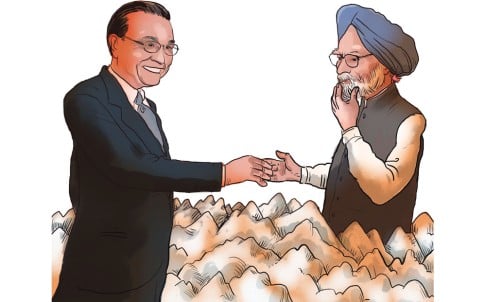‘Southern silk road’ linking China and India seen as key to boosting ties
October 23, 2013
Ancient trade route between India and China seen offering huge economic potential but New Delhi worries over security implications
An ancient trade route where old suspicions intersect opportunities for trade and exchange between Asia’s two giants will be in focus during Indian Prime Minister Manmohan Singh’s Beijing trip, with China wanting India to fast-track an ambitious regional project.
 Beijing is keen to develop a Bangladesh-China-India-Myanmar (BCIM) economic corridor along the “southern silk route” that extends from Yunnan to India. The route, dating back to second century BC, would shorten travel time, cut transport costs, provide landlocked Yunnan province with access to the Bay of Bengal, open up markets and create production bases along the way.
Beijing is keen to develop a Bangladesh-China-India-Myanmar (BCIM) economic corridor along the “southern silk route” that extends from Yunnan to India. The route, dating back to second century BC, would shorten travel time, cut transport costs, provide landlocked Yunnan province with access to the Bay of Bengal, open up markets and create production bases along the way.
The plan for the BCIM corridor is also at the centre of Premier Li Keqiang’s offer of a “handshake across the Himalayas”. It was during Li’s visit to India this year that the corridor first found mention in official statements, even though it was mooted more than a decade ago.
India, on the other hand, is fearful of the security implications of allowing China direct access to its border states and being overrun by China’s more developed economy. But several Indian experts see in the BCIM plan the promise of economic salvation for the country’s impoverished northeastern states and are urging the government to seize the opportunity.
“As Yunnan is the most advanced in the cluster, India fears that it will become BCIM’s economic centre, with the rest of the region reduced to its periphery,” says Binoda Kumar Mishra, the director of India’s Centre for Studies in International Relations and Development.
Mishra is also the secretary-general of the Kolkata to Kunming (K2K) Forum, one of the organisations behind the first K2K car rally, which crossed the route that makes up the heart of the proposed BCIM corridor.
Land connections – through the central Asian silk route and the Yunnan-India southern silk route – were what drove trade between ancient India and China. In second century BC, Zhang Qian, a Han-dynasty envoy to central Asia, reported that goods from Sichuan and other southwestern regions of the empire were reaching Bactria (present-day Afghanistan) through India. By the seventh century, the route had become a bustling channel for trade and migration.
According to Tansen Sen, the author of Buddhism, Diplomacy, and Trade: The Realignment of Sino-Indian Relations, there was robust activity along the route during the first half of the 20th century. “Chinese merchants dealing in tea and horses connected southwestern China, Tibet, east and northeast India,” Sen says.
 During the second world war, the land route was re-established from Kunming to Ledo in India’s Assam state through the Stilwell Road to support Chinese and allied soldiers fighting the Japanese. It is the shortest land route between northeast India and southwest China.
During the second world war, the land route was re-established from Kunming to Ledo in India’s Assam state through the Stilwell Road to support Chinese and allied soldiers fighting the Japanese. It is the shortest land route between northeast India and southwest China.
China was keen to reopen that road, but as the Indian Army was wary it might give China a tactical advantage in case of conflict, China has turned its attention to an alternative – a longer route that runs from Kunming to Imphal in northeast India through Ruili in Yunnan and Mandalay in Myanmar. But even that has failed to allay the fears of Indian strategic analysts, who point to China’s involvement with rebel groups in India’s northeast in the past.
“A BCIM road would give China an opportunity to influence insurgencies in the region. China did this until 1986,” says R. Hariharan, a retired colonel at the Chennai Centre for China Studies, even as he acknowledges the corridor’s economic potential.
The idea of BCIM is to first put in place a highway system along the land route and then turn it into an economic corridor with trading entrepots, tourism infrastructure and manufacturing hubs, possibly hosting production lines displaced from China and creating jobs along the corridor. But the sheer logistics of the 1.65 million square kilometre corridor, encompassing an estimated 440 million people, worry Ravi Bhoothalingam, who is on the Indian government’s panel on BCIM.
“The area is huge, ecologically complex, ethnically diverse and needs the co-operation of multiple administrations,” he says. “All these issues need to be studied.”
To some, like Subir Bhaumik, the author of Troubled Periphery: Crisis of India’s Northeast, that sounds like foot-dragging and “classic Indian insecurity”. Bhaumik, who says a strong defence and commerce ministry lobby in India is blocking BCIM, turns the logic of security concerns on its head.
“The corridor would give China a stake in the Indian economy and hence give it more incentive to maintain peace on the border,” he argues.
India must move on and open up these trade routes, says Sen, who sees in BCIM a chance to revive the commercial bustle of yore.
One comment on “‘Southern silk road’ linking China and India seen as key to boosting ties” Post your comment








google app development language…
Southern silk road linking China and India seen as key to boosting ties : Indian Tollways…